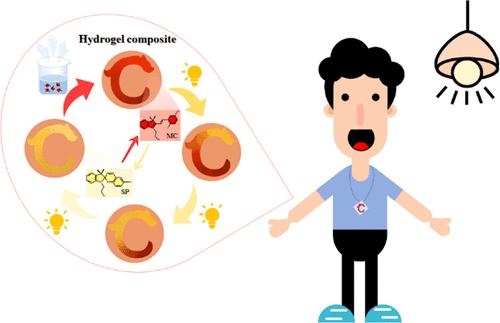一种基于螺吡喃的水凝胶复合材料,可用于监测可见光强度以预防近视的可穿戴检测器
IF 8.2
2区 材料科学
Q1 MATERIALS SCIENCE, MULTIDISCIPLINARY
引用次数: 0
摘要
利用含羟基光响应螺吡喃(SPOH)的水凝胶复合材料的抑制光致变色特性,实现了一种监测可见光强度的可穿戴探测器。当暴露在可见光下时,SPOH经历了一个开环到闭环的转变,伴随着从红色到黄色的变色。与溶液中不同,光致变色率与交联点密切相关。交联剂用量从40 mg减少到5 mg,使SPOH的光致变色速率提高了300%。受中国红山玉龙的启发,水凝胶复合材料被塑造成一个龙,以监测光强度。通过增加头部、身体和尾部交联剂的数量,从一个区域到另一个区域的光致变色/变色速率依次变慢。在含有较多交联剂的水凝胶复合材料中实现变色需要较高的光强度。由于最初的颜色是相同的,通过检查这些含有不同数量交联剂的碎片的变色情况,可以很容易地追踪光强度。基于这种独特且可逆的光致变色能力,本发明的水凝胶复合材料可用于监测可见光强度,以预防近视,特别是儿童和学生。本文章由计算机程序翻译,如有差异,请以英文原文为准。

A Spiropyran-Based Hydrogel Composite for Wearable Detectors to Monitor Visible Light Intensity to Prevent Myopia
A wearable detector to monitor visible light intensity is realized by the restrained photochromism of a hydrogel composite containing light-responsive spiropyran with hydroxyl groups (SPOH). When exposed to visible light, the SPOH experiences a ring-opening to a ring-closed transition accompanied by discoloration from red to yellow. Unlike in the solution, the photochromism/discoloration rate is strongly correlated to the cross-linking points. By reducing the amount of cross-linker from 40 to 5 mg, the photochromism rate of SPOH is 300% faster. Inspired by the Chinese Jade Loong from Hongshan, the hydrogel composite is shaped into a Loong to monitor the light intensity. By increasing the amount of cross-linker in the head, body, and tail, the photochromism/discoloration rate sequentially turns slower from one region to the other. Higher light intensity is required to realize the discoloration in the hydrogel composite containing a larger amount of the cross-linker. Because the initial colors are identical, the light intensity can be easily traced by checking the discoloration of these pieces containing different amounts of cross-linker. Based on this unique and reversible photochromic capability, the present hydrogel composite can be used for monitoring the visible light intensity to prevent myopia, especially for children and students.
求助全文
通过发布文献求助,成功后即可免费获取论文全文。
去求助
来源期刊

ACS Applied Materials & Interfaces
工程技术-材料科学:综合
CiteScore
16.00
自引率
6.30%
发文量
4978
审稿时长
1.8 months
期刊介绍:
ACS Applied Materials & Interfaces is a leading interdisciplinary journal that brings together chemists, engineers, physicists, and biologists to explore the development and utilization of newly-discovered materials and interfacial processes for specific applications. Our journal has experienced remarkable growth since its establishment in 2009, both in terms of the number of articles published and the impact of the research showcased. We are proud to foster a truly global community, with the majority of published articles originating from outside the United States, reflecting the rapid growth of applied research worldwide.
 求助内容:
求助内容: 应助结果提醒方式:
应助结果提醒方式:


